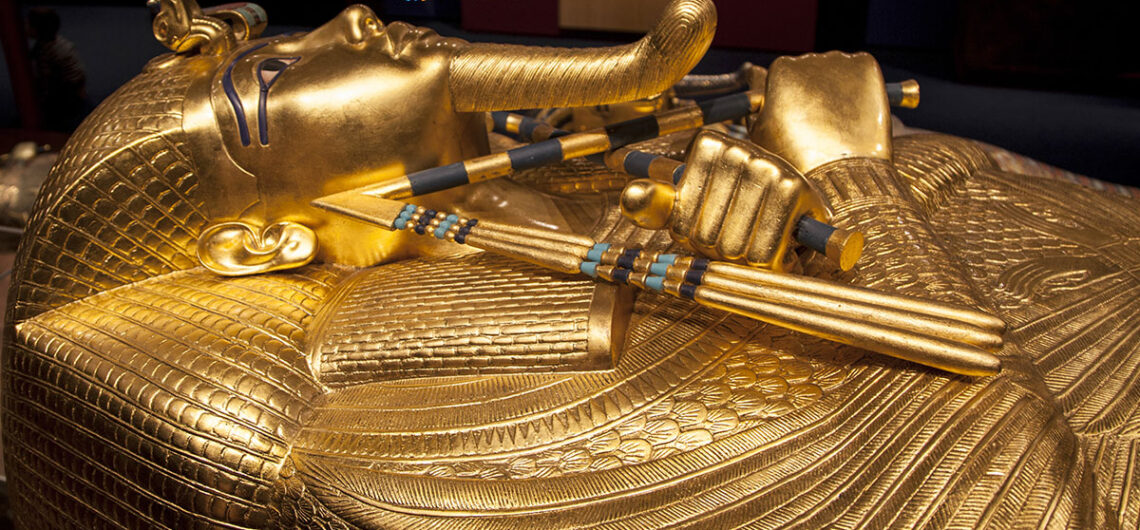Tomb of Tutankhamun in Valley of the Kings, Luxor “Thebes” Egypt | Secrets Curse of the Pharaohs & Discovering the most important Pharaonic Egyptian Tombs and Howard Carter.
Tomb of Tutankhamun number: KV62 in the tombs of the Valley of the Kings.
Tomb of Tutankhamun Facts
Secrets you never knew before Tomb of Tutankhamun:
- It was discovered that the cemetery workers widened the door opening in order to enter the huge Funerary Equipment furniture, such as The great niches Accordingly, the arrangement of the Tomb of Tutankhamun was reversed and the royal burial ceremony was different due to the speed of his burial after his sudden death and the desire of king Ay Quickly control the Ancient Egyptian Government before the return of the country King Horemheb from the war with Hittites.
- After digging and excavating for more than 4 years, starting from 1921 until 1922 AD, in the Valley of the Kings area, the result was disappointing for Howard Carter “have Howard Carter House in Luxor”, The English businessman, The Earl of Carnarvon “Lord Porchester, George Edward Stanhope Molyneux Herbert, 5th Earl of Carnarvon”, decided to return to England and stop funding exploration and research operations.
- After a short period, he Howard Carter “Egyptology” Working alone in the research with his own funding, but he was unable to complete the research due to his weak financial capacity, he traveled to Lord Carnevon’s palace in England, He convinced him, until it was agreed to finance the drilling and excavation project for one season only (the season lasts 3 months).
- It was discovered that there were artifacts that were intended for the King Akhenaton “with his wife Queen Nefertiti” father King Tutankhamun, The name of the father, King, was then deleted and the name of King Tut was replaced.
- Much of the jewelry and Clothing in ancient Egypt discovered in the cemetery was examined and found to belong to king Smenkhkare “The younger brother of King Akhenaten” and get Coronation of the Pharaohs.
- king Smenkhkare period was very short and he married Queen Meritaten the second daughter of King Amenhotep IV to have a hand in the conflict between the Egyptian Pharaohs kings Eighteenth Dynasty in the era The New Kingdom in ancient Egypt.

- George Carnarvon sold the right to publish news and details of the discovery of Tut’s tomb only to the British newspaper “The London Times“.
- There was love on the part of George Carnarvon’s daughter, Evelyn, for Howard Carter, But he was only interested in the treasures of Tomb of Tutankhamun, which led to a rift between him and her father and problems.
- Was fired Howard Carter from Egypt permanently after he refused entry to Egyptians to visit Tomb of Tutankhamun. The decision came officially from the Egyptian Ministry of Tourism, by Markus Pasha.
- A group of Pharaonic artifacts and Egyptian Antiquities were recently discovered in a room next to the burial chamber. They are plaster plugs to close the entrance to the royal cemetery, with inscriptions and cemetery seals of the god written on them. God Anubis “The Cemetery Guardian – The Egyptian Gods” and beneath it are drawings of nine kneeling captives, in addition to the discovery of wooden sarcophagi and a group of baskets for storing fruits and vegetables (pomegranates, figs, buckthorn, doum) “Food in ancient Egypt” and a number of stoppers made of clay with the seals of the workshops engraved on top.
- King Tutankhamun built his main tomb in the Valley of the Kings as soon as he assumed the throne of Egypt, but unfortunately King Tut died at a young age and his royal tomb was not complete, so the minister, Ay, began the royal Mummification in ancient Egypt ceremony for 70 days and transferred him to his current tomb, which is considered to be The Tomb of King Ayi | KV23 / WV23, It indicates the development of Ancient Egyptian science and Medicine in ancient Egypt.
- The workers and engineers could not quickly finish drawing the funerary texts by Ancient Egyptian Language and writings on the walls in the long corridor and the rest of the stone except the burial chamber.
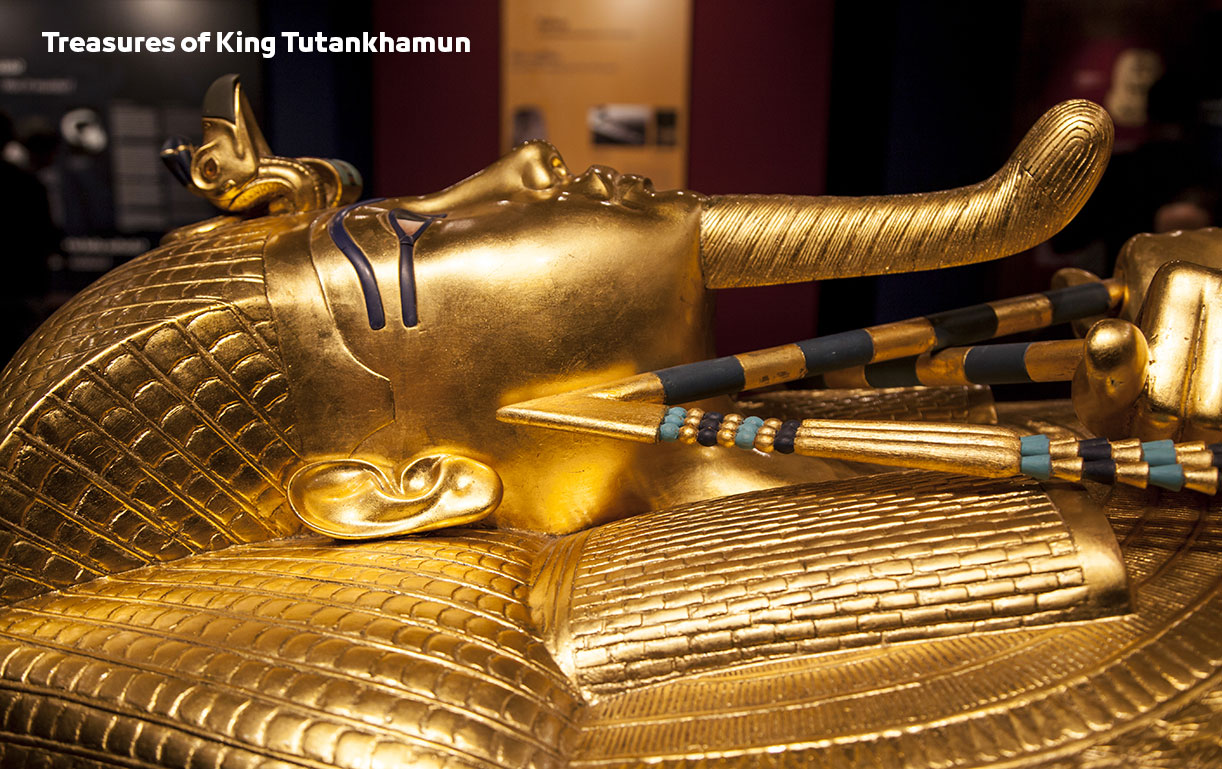
Why wasn’t the Tomb of Tutankhamun stolen and discovered?
It is the only cemetery out of 63 cemeteries in the valley that has not been stolen by Ancient Egyptian Grave Robbers during the spread of chaos and Revolutions in Ancient Egypt.
There are several reasons that clearly helped to hide the features of the tomb door, in addition to its disappearance from the sight of thieves of the royal tombs for more than 200 years after the burial. The Mummy and the completion of the funerary burial ceremonies of the Pharaonic monarchy of King Tutankhamun according to the religious beliefs and rituals of the Ancient Egyptian religion.
to rule King Ramses VI He ruled the throne of ancient Egypt for 200 years after the death of King Tutankhamun, and his tomb was built at the entrance to the tombs of the Valley of the Kings. Small huts were built on top of the entrance to King Tut’s tomb, in addition to throwing debris and small stone rocks at the entrance to the Tomb of Tutankhamun, and they remained like this for 3,000 years.
They were drillers Tomb of Ramses VI ““Double Cemetery Between Tomb of King Ramses V + King Ramesses VI | KV9″ residents of the village of Deir el-Medina remain in the pits to build the royal cemetery for 6 days and then return at the end of the week to their families. Therefore, these huts were unintentionally built directly above the entrance to spend the night and live in, To tell us how the art of sculpture developed in ancient Egypt and the arts of engineering and Architecture in ancient Egypt during the era of King Tutankhamun..
Large stones have accumulated at the entrance to the Tomb of Tutankhamun for a long time, as a result of the fact that the entrance to King Tut’s tomb is located under the stairs of the entrance to the tomb of King Ramesses VI..
Building a group of workers in the valley in the past during a The Ramesside Period “The beginning of the rule of King Setnakhte of the Twentieth Egyptian Dynasty“, the dwellings were located above the ruins of Tut’s tomb, so they remained hidden from tomb robbers.
The location of Tomb of Tutankhamun is between the flood paths of rain and torrents, which caused the accumulation of stones and stone deposits at the entrance for many years..
The complex architectural design of the entrance to the royal Ancient Egyptian Coffins chamber of King Tut, where there were corridors and more than one door to reach the burial chamber..
Why was King Tut’s mummy not moved? Tomb of Tutankhamun
The Mummy of King Tutankhamun was subjected to several studies and examinations, which resulted in much damage to the body, cutting it into 18 pieces, separating all the limbs of the body, starting from the legs and arms, and breaking the rib cage with sharp tools and a knife that Carter used while removing the Golden Mask “Ancient Egyptian Metallurgy“.
The mummy is now kept on a wooden board surrounded by a tight glass box to protect it from interaction with the outside air, dust, germs, and from interaction with oxygen and any fungi and microbes, in addition to devices allocated to the burial chamber to maintain the temperature and humidity in the chamber.
Map of the interior layout of Tomb of Tutankhamun:
Much evidence by Egyptology has been discovered that the Tomb of Tutankhamun was dedicated to a king Ay Or someone from the nobility and not a royal tomb, as the walls of the tomb were not decorated with drawings and engravings from The Book of the Dead only inscriptions in the burial chamber are sufficient.
Tomb of Tutankhamun begins with an entrance, then a staircase with 16 steps, then a downward-sloping vestibule with a length of 7 meters, then a front room in a rectangular shape, where the front room is 8 meters wide and 4 meters wide..
There is a northern corridor that connects you to the king’s sarcophagus chamber and the treasure burial chamber, in addition to a chamber from the western direction.
There are drawings and engravings from the Book of the Dead on the wall of the sarcophagus chamber, in addition to scenes of King Tutankhamun with Ancient Egyptian gods and religious beliefs in the afterlife.

Waiting room – front room:
More than 700 artifacts were discovered in the additional antechamber, which was in a state of chaos as a result of looting and theft by Tomb of Tutankhamun thieves, and among the most important things it contains…
- Funeral bed in the shape of a lion.
- A funeral bed in the shape of a spotted cow.
- Animal-shaped funeral bed with the body of a lion, the tail of a hippopotamus, and the anchor of a crocodile, To indicate the development of Industry in ancient Egypt.
- More than 200 King Tut’s walking sticks.
- Military tools and equipment.
- a group of Ushabti Statue.
- King Tutankhamun’s viewing chair.
- 25 Vials contain Pharaonic royal Ancient Egyptian Food and heKing’s foodBerries use it inHis life after death.
- Complete war chariot parts It was used in wars against enemies with Military of ancient Egypt.
- 3Parts of ceremonial carriages and Pharaonic Festivals in Ancient Egypt.
- Two statues guarding the sarcophagus chamber, painted in black and dressed in gold.
- A large box depicting the military campaigns of King Tutankhamun against the Nubia and Syrian enemies.
The extra room:
Located in the western direction and branching off from the main front chamber, the entire contents of the Tomb of Tutankhamun were found without arrangement.
Coffin chamber – burial chamber:
The royal sarcophagus room was designed at a lower level than the main front room by 1 metre.
A square-shaped cavity was excavated in the wall of the room and covered with limestone slabs.
Contents of the burial chamber: Tomb of Tutankhamun
- The large box is made of wood to place the coffin.
- An alabaster jar representing the union of Upper and Lower Egypt with the ancient Egyptian civilization as in Geography of ancient Egypt.
- Lamps depicting the god Hapi.
- The king’s royal scent vessels.
The walls of the coffin chamber:
You will see Pharaonic drawings and engravings from the Pharaonic Book of the Dead, where the ceremony of opening the mouth and the king was drawn in the presence of a group of ancient Egyptian gods..
Where King Tutankhamun’s journey in the afterlife begins, the ritual of opening the king’s mouth in a form God Osiris with his minister, that is, then meeting the God of Heaven.” God Nut Then drawings of the king with Osiris.
On the western wall you will see King Tut’s journey with God Ra in the form of a beetle in the sun’s boat, underneath it are engravings of 12 monkeys representing the twelve hours of the night.
Where the drawings tell the journey of King Tutankhamun, his journey tonight on the sun boat to meet the god Anubis, God Hathor and God Isis in the other world.
East side chamber: Tomb of Tutankhamun
A gilded cupboard was found in the room containing utensils that were intended to store King Tut’s internal organs. They were mummified, namely the intestines, liver, lungs, and stomach, for reuse in his afterlife..
You will notice golden heads in the shape of sacred cobra snakes on top of the cupboard, in addition to small statues of the goddess protecting the utensils.
A golden and black statue of the god Anubis was found mounted on a chair.

Was the tomb belonging to King Tut?
- A dangerous secret was discovered, that the Tomb of Tutankhamun was intended for the burial of the Minister Ay, but due to the sudden death of King Tutankhamun at the age of 19 years He was buried after a royal mummification process that lasted 70 days.
- The mummy was buried in a coffin in a cemetery that did not belong to her.
- Pharaonic inscriptions were discovered in the tomb of Minister Ay No. WV23 ““He has Tomb of Ay – Ta 25, that is, among the Tombs of the Nobles Amarna, in Tell el-Amarna, Minya.”” is similar to the current tomb of King Tut, which indicates that it was the one intended for the burial of the young king.
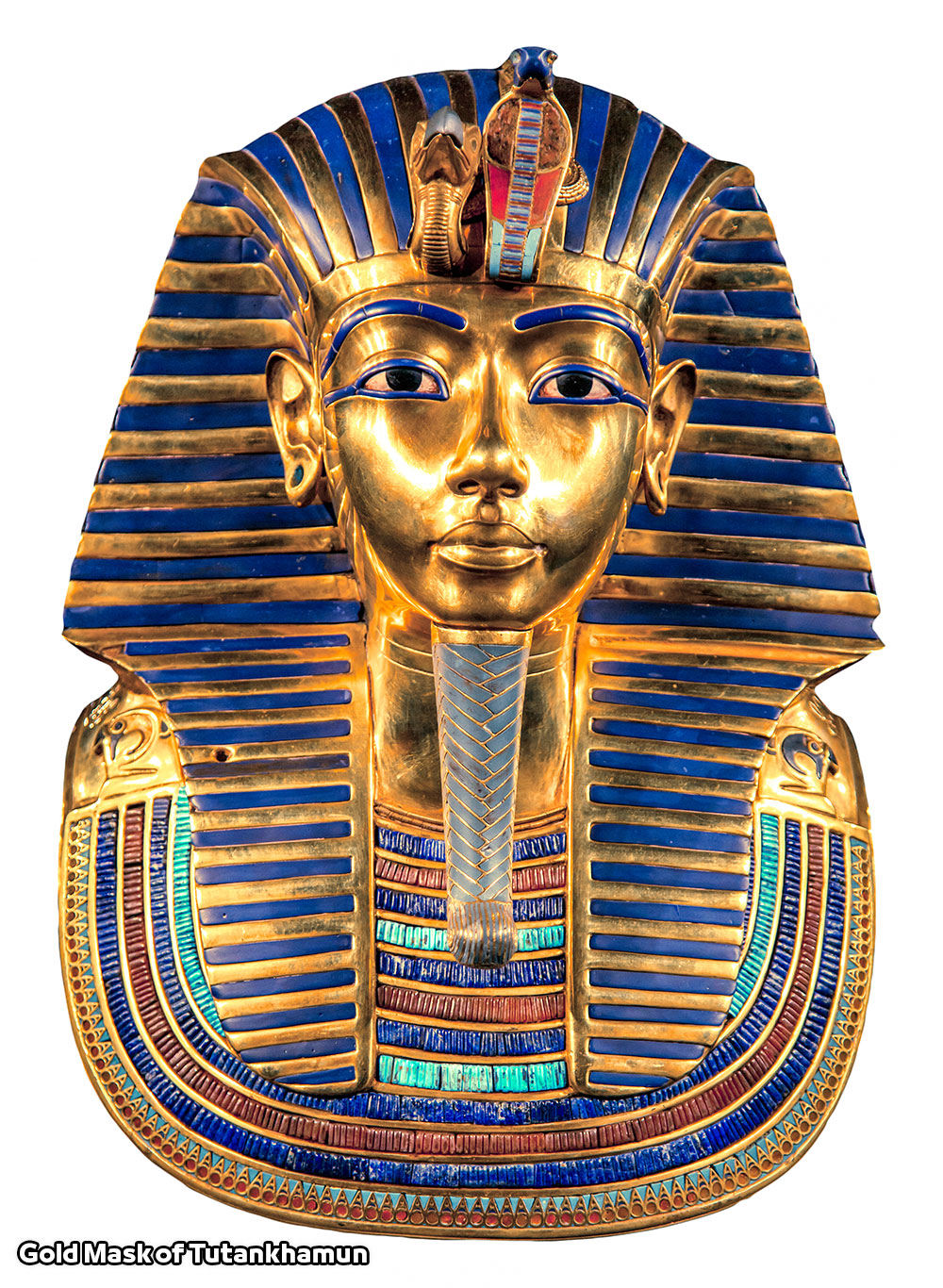
What are the most important possessions of Tomb of Tutankhamun?
Golden Mask of Tutankhamun:
King Tut’s golden mask weighs about 25 pounds and is 2 feet long. Its base is made of pure gold and contains a group of rare gemstones such as obsidian, quartz, and lapis lazuli..
The most important feature of the golden mask is the unique design, the interlacing of gold with blue glass, the lapis lazuli stone in the band of the head cover, and the cobra snake and female osprey on the front of the mask..
Texts were written for the deities Anubis, the god Ra, the god Horus, and the God Ptah and God Sokar in ancient Egyptian language “Hieroglyphic language” Behind the mask to protect him from the afterlife.
The Coffin of King Tutankhamun: Tomb of Tutankhamun
- The royal sarcophagus was made of quartz with a lid of colored pink granite stone, and on it were drawings of goddesses and religious beliefs in the history of ancient Egypt..
- Deposit has been made. The coffin has 4 cupboards made of gilded wood on top of each other.
- The king’s coffin itself was placed in 3 other human-shaped coffins on top of each other.
- The final small coffin of King Tut’s mummy is made of pure gold.
- The dimensions of the large cupboard are 5.08x 3.28 x 2.75 metres.
- The large armoire was covered on top of a large granite stone.
- The large coffin measures 224 cm and was made of cedar wood “The importer indicates the development of Trade in Ancient Egypt” and covered with gold.
- The second coffin is made of cedar wood and studded with rare precious stones and gold.
- The small golden coffin weighed 110 kg.
- The mask of King Tutankhamun was on the small golden coffin.
- 150 pendants and figurines were discovered in the small sarcophagus.
- 11 wooden paddles were discovered, which were special for the king’s sun boats for his afterlife.
- It was discovered that the coffin was intended for another Pharaonic king and not for King Tutankhamun.
- On every corner are drawings of an ancient Egyptian goddess guarding the body”And they are”Isis and God Nephthys and God Serket and God Neith“.
- King Tut’s body was placed in 3 coffins on top of each other, two of gilded wood and the other of pure gold, weighing 110 kg..
- A gold mask was placed for the mummy Tutankhamun and inlaid with a group of precious gemstones. It weighs 11 kg, namely: agate, turquoise, glass, porcelain, lapis lazuli, quartz, and obsidian.“
- The amount of gold found in King Tutankhamun’s coffin = 108 kg.

Tutankhamun’s Trumpets:
It was found in a burial chamber in 1922 AD. The trumpet was made of silver and another of copper inside an intricate coil of plant sticks..
The length of the royal trumpet is 58 cm, the width of the trumpet is 8.8 cm, and the width of the trumpet tube is 1.7 cm – 2.6 cm..
Tomb of Tutankhamun. The trumpet was decorated with gold in the bell area, in addition to the mouth being made of pure gold.
In ancient times, the trumpet was used as a musical instrument “Magic in ancient Egypt” to start wars and celebrations, so the young king kept it for use in his later life..
The sound of King Tutankhamun’s trumpet was recorded in The Egyptian Museum in Tahrir Square “Museums in Cairo“,The year 1939 AD before Egyptian Ministry of Tourism and Antiquities, But a crack occurred in it, but it was restored again.
Sun god Tutankhamun Scarab Necklace:
The necklace is approximately 15 cm long and 14 cm wide.
The necklace was made of gold and silver and decorated with shapes made of Chalcedonian stone, white and red agate, calcite, turquoise, obsidian and lapis lazuli, using white, black, blue and red glass..
The lower part of the necklace is designed in the form of floral decorations, and the middle part is designed in the shape of a falcon, made of gold studded with precious stones and holding the Pharaonic shin signs, The Egyptian Lotus Flower, and the honeysuckle plant..
The falcon’s body and head are designed in the form of a scarab made of white agate, which represents the sun god Pharaohs” God Khepri “, Two snakes were added on either side of the falcon, carrying a sun disk above its head.
Tomb of Tutankhamun. By carrying the scarab, symbol of the sun and moon, in the form of a sacred boat, above an eye Pharaonic Scarab, the left one is a drawing of God Horus, Then around the eye drawing Snakes Sacred to the ancient Egyptians, it has a drawing of a sun disk bearing a crescent.
Inside the moon disk are carvings of King Tutankhamun standing between the God Thoth devout.
The importance of King Tut keeping the necklace with him is due to it being considered sacred and linked to the king’s accession to the throne of Egypt on the Lunar New Year, It indicates the development of Astronomy in ancient Egypt.
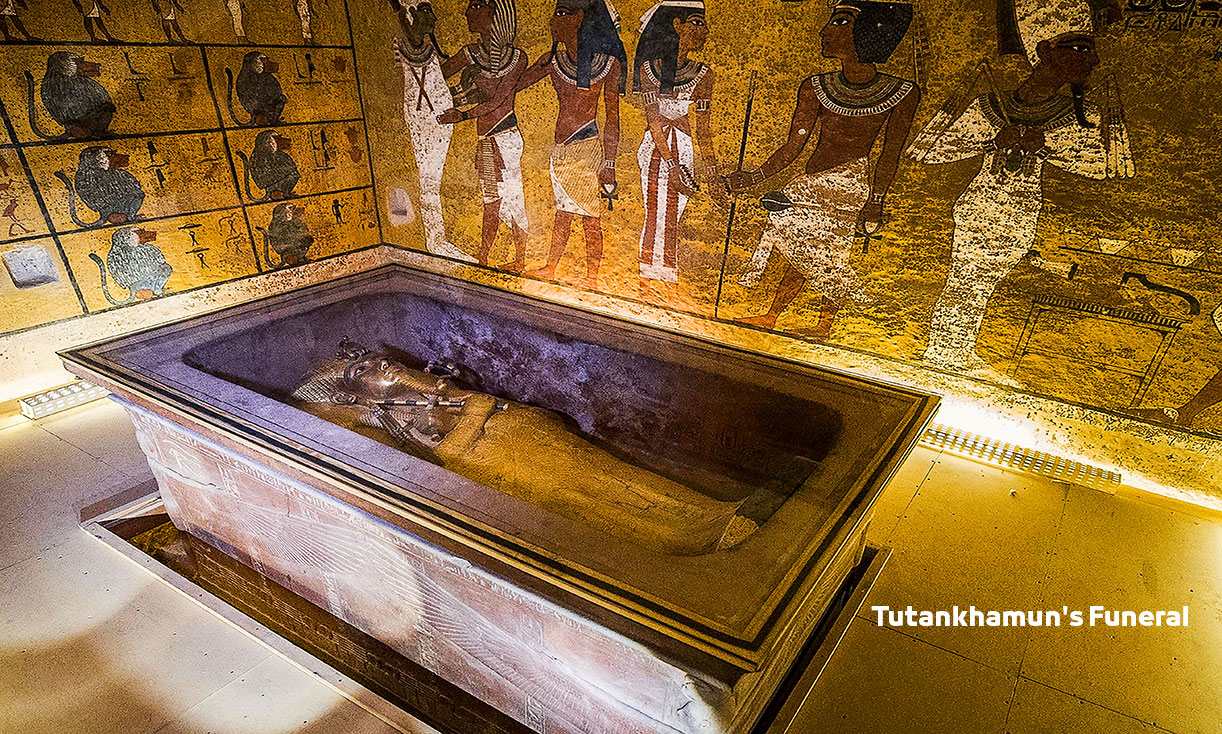
Detection Stages Howard Carter Tomb of Tutankhamun:
Carter was initially working in Egypt as an artist who drew inscriptions, drawings, and writings and copied them from the walls of Egyptian Temples and Pharaonic tombs.
Then he met archaeologist Flinders Petrie by chance and began learning how to excavate and excavate antiquities, record them accurately, and take care of them until he became a famous, professional archaeologist.
He gained experience in knowing the Valley of the Kings region well as a result of his work as an antiquities inspector for 5 years and studying the excavations and artifacts and Egyptian Monuments that were discovered. The Royal Cache of Deir el-Bahri Which bears the name of King Tut.
Meet the English businessman Lord Carnarvon, after being expelled from the Egyptian Antiquities Service due to his harsh and arrogant manner with a group of tourists and his refusal to apologize to them, became unemployed and looking for a financier to finance discoveries. the Valley of the Kings, he agreed with Lord Carenvon to finance it, and he continued working and excavating for 4 seasons (one season = 3 months) to no avail until Lord Carenvon decided to return to his palace in England, then Carter traveled there in order to convince him to finance it for one season only.
Lord Carnevon loved the Pharaonic antiquities and the weather of Egypt and came there every year to sail in the Nile River with his own boat, he was one of the businessmen most passionate about financing excavations. It is mentioned that he was involved in a car accident when he was young, so he came to Egypt to enjoy the winter sunshine and discover Egypt Archaeological Sites and Egyptian Tombs Pharaonic in addition to healing at the same time.
has been started Howard Carter Excavation and excavation in front of the tomb of King Ramesses VI on February 1, 1922 AD. Initially, all the workers’ huts were photographed and drawn. Deir el-Medina the antiquities were then completely removed unprofessionally.
On February 4, 1922 AD, one of the young workers, the Sheikh’s cousin, attacked a member of the Abdel Rasool Family by digging with his hands to place the water jars in their place, it was by chance that he discovered a staircase 13 meters underground beneath the tomb of King Ramesses VI.
Tomb of Tutankhamun. The boy quickly went to a tent Howard Carter To tell him what he discovered for a reward, he rose Howard Carter, he got rid of all the sand around the stairs to discover that it was a royal Pharaonic tomb that had not yet been discovered.
Howard Carter He hurried to send an urgent telegram to Lord Carnarvon in England that he had found a royal tomb and asked him to come and to Egypt quickly to open the cemetery in the Valley of the Kings in Luxor.
The process of cleaning the entire entrance to the cemetery began, starting with removing sand from the stairs down until reaching a tightly closed door bearing the seal of the cemetery guards in the name of King Tutankhamun.
receipt Lord Carnarvon accompanied by his daughter to the Valley of the Kings excavations on February 24, 1922 AD, that is, 20 days after he received the telegram from Carter.
The Egyptian workers began cleaning the Tomb of Tutankhamun from the inside until the first door was opened, then cleaning the long corridor and removing all the dust, sand and stones until they reached the end of the long corridor, which ends with a plastered door.
The English archaeologist began Howard Carter by discussing with Lord Carnarvon that King Tut’s burial chamber is located behind this door.
On February 26, 1922 AD, he rose Howard Carter Standing next to him, Lord Carnarvon excitedly drilled a small hole in the door, then lit a candle to test the strength of the air inside, then enlarged the hole so that he could see what was inside.
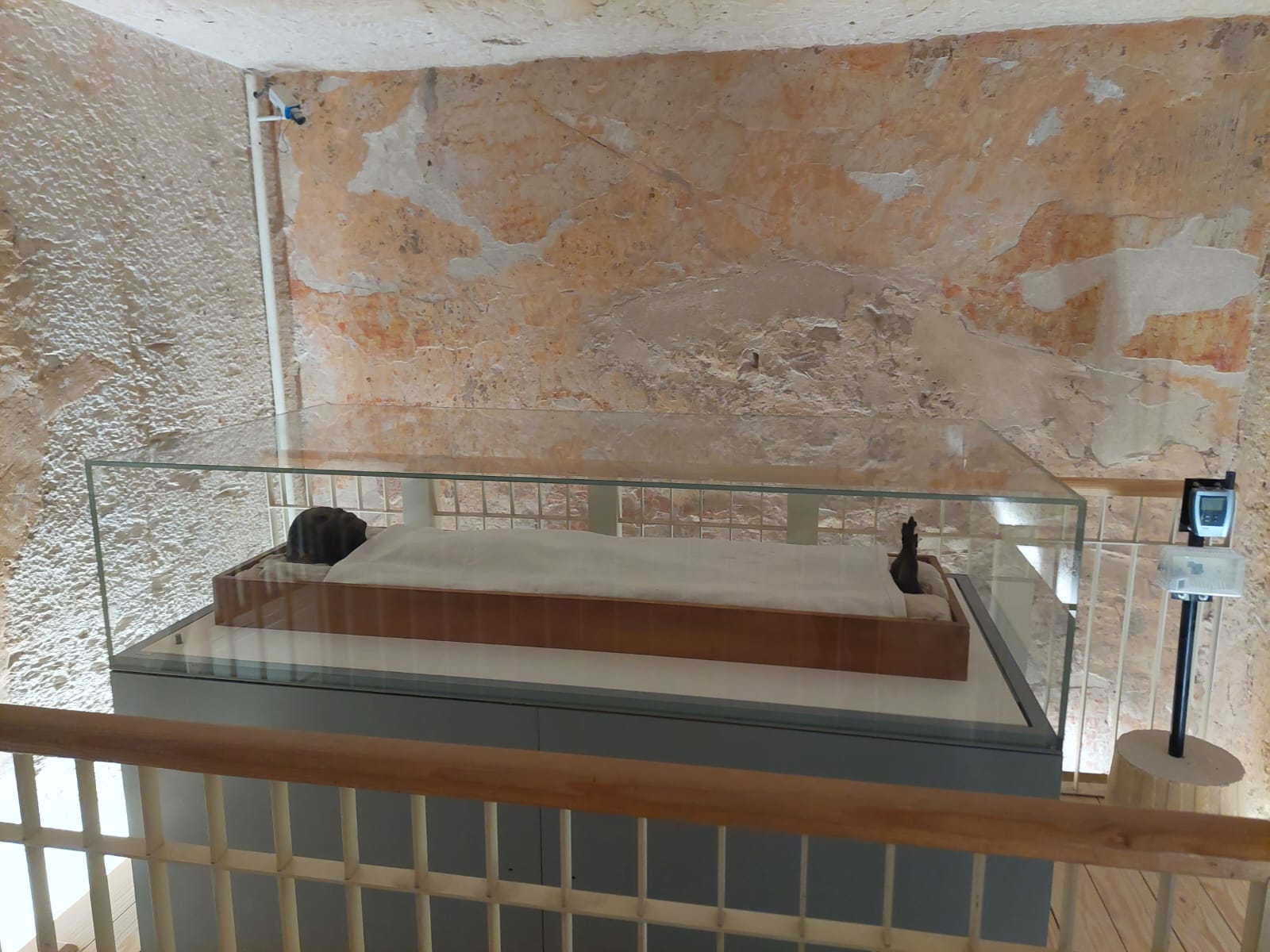
He asked Lord Carnarvon: what do you see?
He replied Howard Carter Excited and happy: wonderful things.
After professionally breaking down the door, 4 rooms were found containing more than 5,000 artifacts belonging to King Tutankhamun, in addition to the mummy of the Pharaonic king in good condition, preserved inside 3 golden coffins, in addition to the unique golden mask inside multiple wonderfully beautiful compartments.
Recording, drawing and photography began5398A Pharaonic artifact for 10 years.
The artifacts in Tomb of Tutankhamun, treasures and all their contents were transferred to King Tut for display in the Egyptian Museum in Tahrir, but now they have been displayed in a special exhibition hall in The Grand Egyptian Museum after being completely restored.
The mummy of King Tutankhamun was left in its place in the burial chamber, preserved.
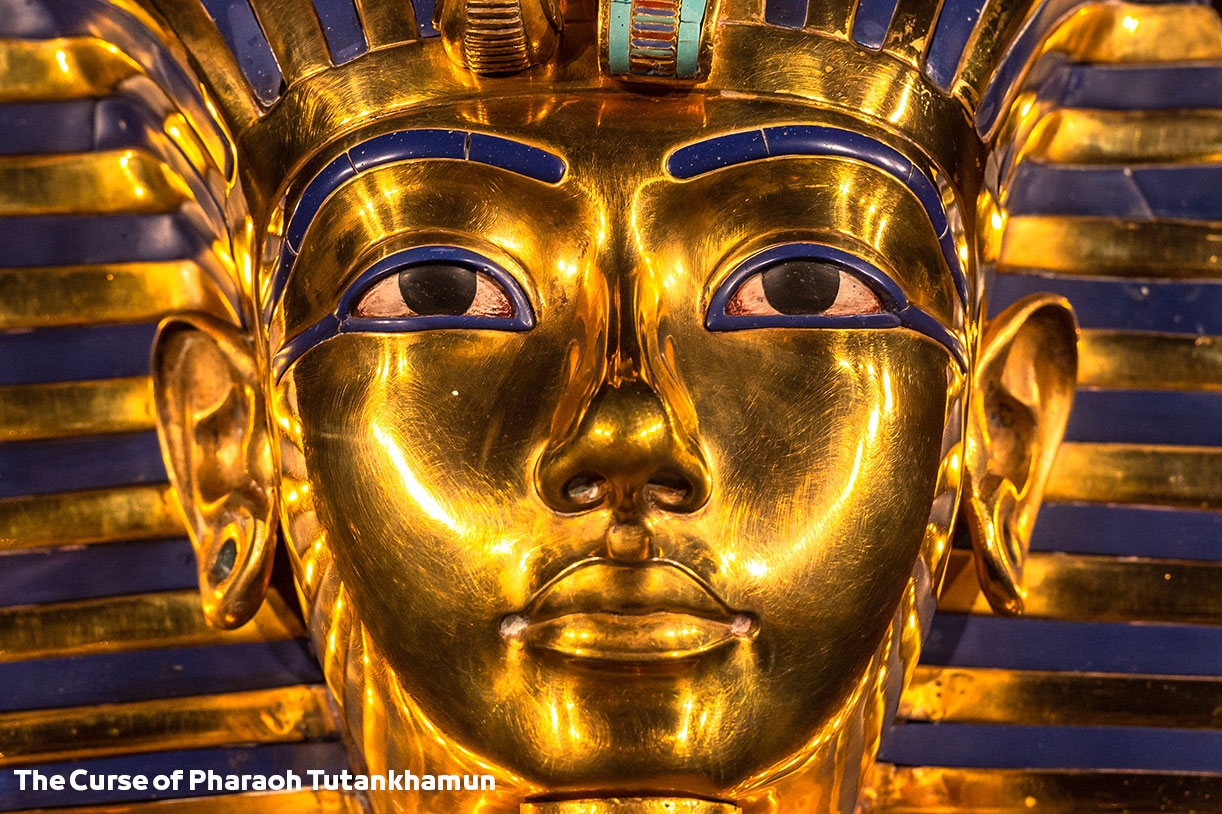
Has King Tut’s tomb been robbed before?
Tomb of Tutankhamun had been subjected to two robbery attempts before Ancient Egyptian Grave Robbers from residents Thebes Western “It was a period of chaos and justice and Law in Ancient Egypt were not applied in ancient Egypt “Maat”, but the attempts failed and the thieves were unable to enter the burial chamber.
In the first attempt, the cemetery guards succeeded in arresting and taking them out, while in the second attempt, the treasures and lightweight, easy-to-carry artifacts located in front of the door of the burial chamber were stolen.
Did he steal? Lord Carnarvon W Hayward Carter Tomb of Tutankhamun?
He thought Lord Carnarvon and Howard Carter, They will divide the treasures and artifacts 50% to them and 50% to the Egyptian government, but unfortunately there were strict laws prohibiting the division of the artifacts if the entire tomb was discovered, and this is what actually happened in the process of discovering the Tomb of Tutankhamun.
Both have already done so Lord Carnarvon and Hayward Carter By stealing small-sized antiquities and hiding them from view until traveling to England and then giving them as gifts to friends or keeping them.
Artifacts belonging to Tomb of Tutankhamun were found hidden in a secret hideout in a castle Lord Carnarvon in England, this has been documented through Thomas Hoving’s book “Manager The Metropolitan Museum of Art“.
History of the life of King Tutankhamun
Father: King Akhenaten
the wife: Queen Ankhesenamun
the mom: Queen Kiya “Female Pharaohs”
Grandpa: King Amenhotep III with Queen Tiye
Facts about King Tutankhamun:
Tut died under very mysterious circumstances It is believed that the military commander Hor Moheb was the one who killed him from behind, as it became clear after examining the mummy that there was a crack at the bottom of the skull and that he deleted his name from the royal records and removed his name from the walls Mortuary Temples.
The minister, that is, Queen Ankhesen, married“Amon”Wife of Queen Tut” immediately after his death and became Pharaoh of EgyptFor a short period.
King Tut’s height at his death was 170 cm.
Have been foundmore100 walking sticks that King Tut used to walkWhich indicates health problems with the feet.
Drawings and engravings were discovered Pharaohs King Tut was sitting on the chariot while shooting arrows, which indicates that he was injured in the legs and had difficulty standing on the chariot..
How did King Tutankhamun die?
In 2010, after many studies, it was discovered that the cause of King Tutankhamun’s death was…:
- Malaria infection.
- The king acquired hereditary diseases from grandparents and parents Pharaohs kings a genetic defect occurs as a result of marriage between a brother and a sister in the royal family.
- A double fracture occurred in the king’s left thigh, and it appeared on the Pharaonic engravings that were discovered that King Tutankhamun was holding a staff..
There are many theories about the reasons for the death of King Tutankhamun
Tomb of Tutankhamun. As a result of not obtaining much evidence and that he died at the young age of 19 years, there are many explanations, some of which are supported by evidence:
- After using anatomical imaging techniques on the mummy of Tutankhamun, Egyptian archaeologist Dr Zahi Hawass discovered, especially, the reason for the presence of an opening in the mummy’s skull. The reason is the stages of operation mummification for the king, while the fracture in the left thigh bone of the young king was the result of the inflammatory disease that the king was afflicted with.
- King Tut suffered from Marfan syndrome that It is the result of the inheritance of genes between parents, children and sisters within the same family.
- There were explanations from a team of researchers from the Egyptian Ministry of Antiquities that the cause of death was poisoning of the young king’s blood as a result of a broken bone in the left thigh..
- A blood stain was discovered under the skull of King Tutankhamun. A team of researchers from the University of Liverpool and the University of Michigan explained this as a result of the young king receiving a blow to the head from behind, which then caused internal bleeding in the head and then rapid death..
The importance of discovering the treasures of King Tutankhamun:
- All artifacts have been found and Funerary furniture, the property of the Pharaoh that was buried after his death for use in his next life after death, as was believed in the culture of the Pharaonic civilization..
- 358 pieces were found, including three Coffins above some and the golden king’s mask.
- All artifacts from the Eighteenth Pharaonic Dynasty.
- Learn about the life of the little king and all the details of his life.
Tutankhamun’s Mummy:
- The Egyptian government restored the mummy for two years.
- A mummy was damaged after it was displayed in a CT scan machine to find out the mummy’s secrets.
- It was damaged and disintegrated into 18 pieces when Howard Carter tried to remove the golden mask and take it out of the coffin in the cemetery..
- The mummy of King Tutankhamun was displayed in 2010 in the city Luxor with the completely golden coffin and shrine for visitors of all nationalities around the world.
- It was discovered by DNA analysis and X-ray scanning of the mummy of the young king that King Akhenaten is the father of King Tutankhamun.
Tomb of Tutankhamun Location:
The West Bank, the Valley of the Kings Luxor, Egypt
Tomb of Tutankhamun Opening Hours :
Every day from 06:00 am to 17:00.
Tomb of Tutankhamun Ticket prices:
Adults = 500 Egyptian pounds.
Student = 250 Egyptian pounds.
Note: The prices of entry tickets to the tombs of the Valley of the Kings and the Tomb of Tutankhamun will be increased by 30% starting next June 2024.
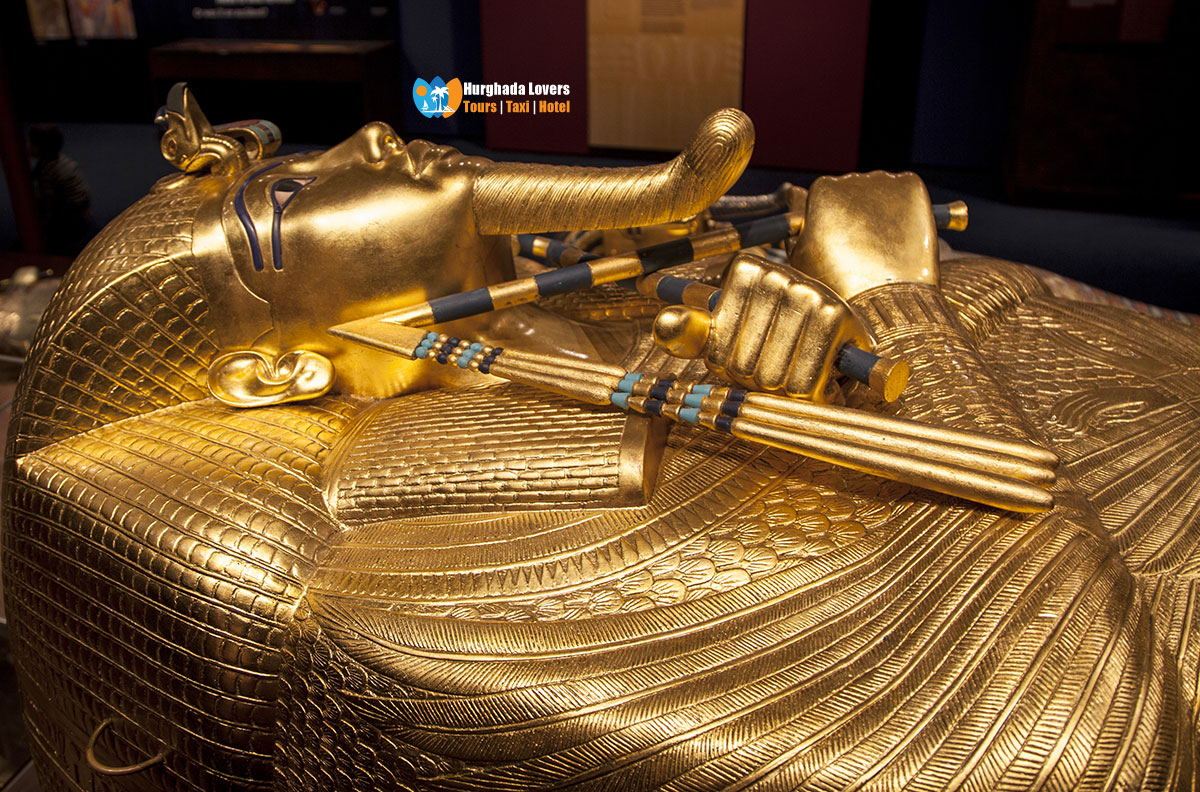
FAQ – questions and answers:
Why is Tomb of Tutankhamun famous?
- It is considered the only cemetery that has not been robbed by tomb robbers.
- All the golden treasures and tools of the king that were buried with the coffin after his death were discovered.
Who discovered Tomb of Tutankhamun?
The cemetery was discovered after many attempts by archaeologists, until the British scientist Howard Carter came and excavated through a large expedition in 1922 AD..
What did King Tutankhamun achieve during his reign?
- He restored the worship of Amun after his father, King Akhenaten, abolished it.
- Leading military campaigns to protect Egypt’s borders.
How old was King Tutankhamun when he ascended the throne?
Tutankhamun ruled the throne of Egypt when he was 9 years old.
Has Tomb of Tutankhamun been opened?
Yes, Tomb of Tutankhamun was opened in 1922, corresponding to November 29.
British archaeologist Howard Carter officially opened the tomb to the world on February 16, 1923 AD.
Hurghada Lovers best Tour Operator to provide daily tours to visit the Tourist attractions of Luxor by Hurghada to Luxor Day Trips and Cairo by Hurghada to Pyramids Day Trips to discover the secrets. Book online when you come to Hurghada, El Gouna, Sahl Hashish, Makadi Bay, Soma Bay.

